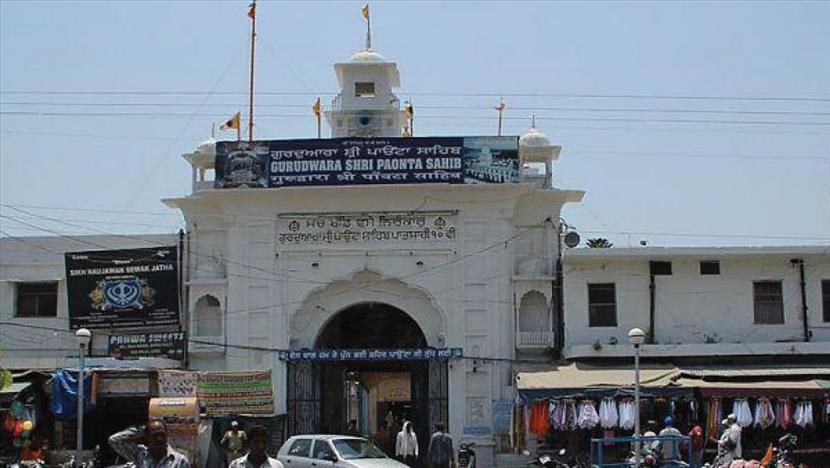Article /
Tourism /
Travel
When a pilgrimage destination is located in a scenic natural environment, the
experience doubles up to be a great adventure. Like my recent trip to Paonta
Sahib with my family.

This small but sacred town is snuggled in the tiny
district of Sirmour, between the borders of Himachal Pradesh and Uttarakhand.
And in the heart of this district, lies the holy site of Gurudwara Paonta Sahib.
It is technically an industrial town but became a revered place owing to this
ancient place of worship. It is considered to the most hallowed place for Sikhs,
as well as for believers from other faiths. Every day, Sikh devotees from not
only across India, but also from other parts of the world come to pay their
respects and offer prayers. The gurudwara serves as an important site for
religious activities and a significant place of worship.
The story of Paonta Sahib
There is a very fascinating legend of Paonta Sahib, which my grandma told me on
our journey. It is said, that the Guru Gobind Singh, the tenth Sikh guru, found
this town by happenstance. The legend says that Gobind Singh was traveling on
his horse through this part of the country and happened to make a pit stop. He
felt so warm and welcoming to this place and its people that he decided to stay
here for as long as almost five years, which was quite unlikely for him since he
was a traveling preacher. While staying here, Guru Gobind Singh penned the Dasam
Granth (one of the holy texts of the Sikh), along with many other religious
texts, before he moved to Anandpur Sahib later. Years later, the gurudwara that
still stands today, was built in his honor and pay respect to his teachings. The
gurudwara was originally named ‘Paontika’, which translates as ‘a place where
feet became stable’. In other words, this is where the great Sikh guru found his
footing ground.
Reaching there
We were traveling from Chandigarh, and with my grandparents, so we needed a
reliable mode of transport. Luckily, we got to
book a reliable cab from Chandigarh to Paonta Sahib and
reached in about three and a half hours via NH 7.
Although it is in the plains of Himachal, at the foothills of the Himalayas, the
town gives a taste of the mountain state, especially in its weather. We were
traveling during late winters, which was neither very cold nor warm, making it
the perfect time to enjoy nature in this part of the country. The surrounding
greenery and the holy vibes of the town made it all the more divine.
The religious tour
Once we reached, our first stop was obviously the main gurudwara. The holy site
is recognized by a palanquin, made of pure gold. The place was more than just a
religious sanctum. It was more like a spiritual and social asylum for people,
which reaches out to local communities and people in need. Every day, the
in-house langar (kitchen) serves free meals to pilgrims and the poor. The
gurudwara committee also holds important festivals and community events.
After our detailed tour of the gurudwara, we headed to yet another significant
religious site. At only a few miles from the main town, lied the Bhangani Sahib
Gurudwara. It sat strategically on the banks of the Yamuna River, rendering a
stunning view of the white dome of the temple against the vast water body and
green hills in the background.
Since we had the entire day to explore Paonta Sahib and we still had enough time
in hand, we decided to make one more stop. At about 15 Km from our current
location, lied the sacred site of Gurudwara Shergah Sahib. This place also
boasts another legend of Guru Gobind Singh. It is said that when the great
preacher was passing through the forests in this area, he encountered a
man-eater tiger. Guru Gobind Singh beheaded the predator with a single stroke of
his sword, which he always carried with himself. Thus, the gurudwara was built
to commemorate his valiance and warrior spirit.
A slice of nature
As our last stop for the day and a resting point, we went to see the Asan
Barrage. The most refreshing locale in the region, this huge water body was the
result of a dam built on the confluence of the Eastern Yamuna Canal and Asan
River. The expansive water bodies and its surrounding greenery gave rise to a
wildlife refuge in the area. Every winter this place becomes a mecca of
migratory birds, which I observed on our trip. From painted storks to terns and
pipers, the banks along the barrage was lined with water birds.
Besides its religious significance, Paonta Sahib enjoys a beautiful geographical
setting of the mountain state. Sitting on the banks of the upper reaches of the
Yamuna River, on the backdrop of Lower Himalayas, the place was a delight to the
eyes and fulfilling to the mind.
Pro Tips
If you want to go exclusively for birding at Asan Barrage, visit between late
November and early March.
Alwaysrent a car in Chandigarh with an expert driver, to make your journey
convenient and comfortable.
TAGS:
Paonta Sahib,
Trip to Paonta Sahib,
Seema Gurnani,


